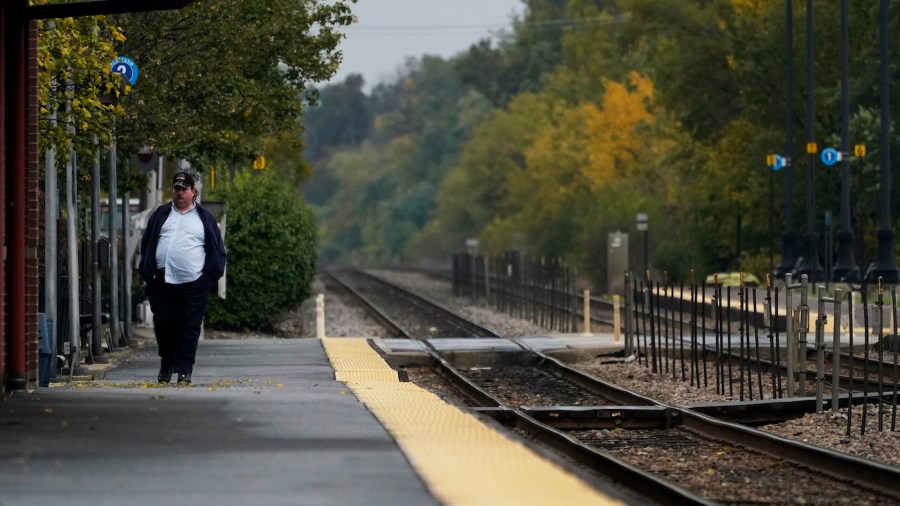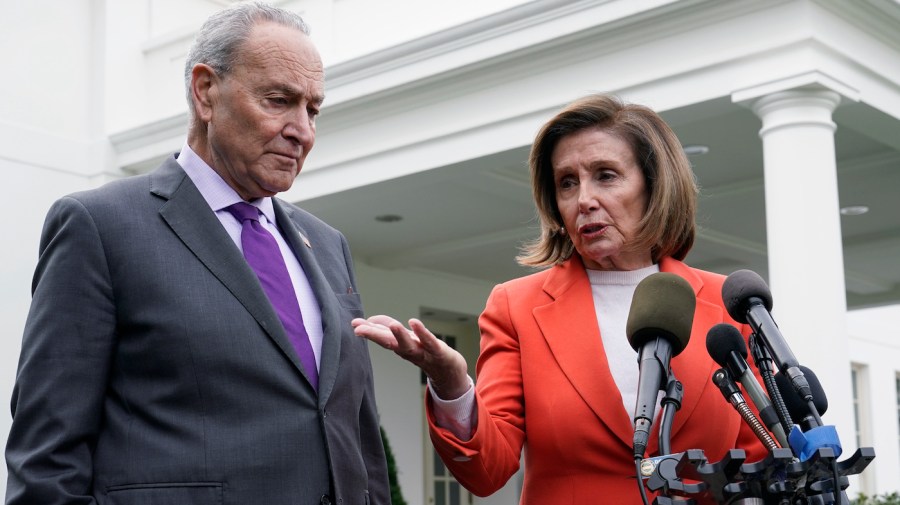Here’s what you need to know about the rail strike Congress is trying to stop
A danger that the White House thought had been averted two months ago is back with a vengeance.
A national rail strike could kick in just a couple of weeks before Christmas, with potentially disastrous effects for the economy and inflation. It would also infuriate millions of Americans whose desire to get the goods they want during the holiday season would almost certainly be thwarted.
The specter of a strike had loomed in September but had seemed to be resolved by a tentative deal between railroad companies and labor unions.
However, several unions have voted that deal down, throwing the process into chaos and creating a sizable headache for President Biden.
Here’s what you need to know.
What is the dispute about?

A Burlington Northern locomotive pulls a long line of military vehicles Wednesday, Nov. 23, 2022, in Colorado Springs, Colo.
Principally, it’s about working conditions and, in particular, paid sick leave.
The railroad unions argue that their members have had to grapple with understaffing, inflexibility and contracts that do not typically permit paid sick leave.
As Bloomberg Law put it earlier this year: “Many rail employees are required to work 12 hours a day and are frequently on-call 24 hours a day, seven days a week. When scheduling time off, rail workers say they often have to make the requests months in advance.”
The unions also point out that their members worked under those onerous conditions throughout the COVID-19 pandemic, preserving a vital element in the nation’s daily life.
The railroad companies, for their part, argue that they have an imperative, like any employer, to keep labor costs low. They also assert that they need to know people will show up for work as expected. And they claim that employees can deal with routine medical issues on their time off.
But wasn’t this resolved? How did we get here?

A passenger waits for a train at a Metra station in Northbrook, Ill., Wednesday, Oct. 12, 2022.
It looked like it had been resolved — but that has unraveled.
In mid-September, it appeared a deal had been struck.
It included significant pay raises — 24 percent from 2020 levels to 2024 levels. The deal also provided for workers to have time off when hospitalized or to attend a limited number of medical appointments — three per year — without penalty.
However, it did not include any commitments of paid sick leave in a more general sense.
Biden nonetheless praised the deal at the time as “an important win for our economy and the American people,” adding that it was also a “win for tens of thousands of rail workers who worked tirelessly through the pandemic.”
But the agreement was always subject to a ratification process from the unions themselves — 12 in all. Eight ratified the deal but four rejected it.
One of the biggest blows came a little over a week ago when the huge SMART-TD union voted down the deal.
SMART-TD — its full title is the International Association of Sheet Metal, Air, Rail and Transportation Workers (Transportation Division) — represents about 28,000 conductors, making it the single biggest rail union.
Why does Congress have the power to solve the matter?

President Joe Biden, center, at the top of a meeting with congressional leaders to discuss legislative priorities for the rest of the year, Tuesday, Nov. 29, 2020, in the Roosevelt Room of the White House in Washington.
The short answer is, because of a combination of the Railway Labor Act (RLA) and the Constitution.
The RLA was passed into law almost 100 years ago, in 1926. The genesis of the law, in turn, reaches back into the latter half of the 19th century. Basically, at that time it was widely recognized that the railroads were so essential to the nation’s life that strikes could not be countenanced.
It therefore provided for arbitration measures, “cooling-off” periods when strikes would not be permitted and other measures.
In addition, as the nonpartisan Congressional Research Service recently noted: “Article I, Section 8, clause 3 of the U.S. Constitution states that the Congress shall have power “[t]o regulate Commerce with foreign Nations, and among the several States, and with the Indian Tribes.’”
The Congressional Research Service added that, “In 1917, the Supreme Court confirmed that Congress has the authority to intervene in rail labor disputes that threaten to disrupt interstate commerce.”
The current dispute clearly falls within that framework.
That’s why Biden on Monday called on Congress to pass legislation that would “adopt the tentative agreement between railroad workers and operators — without any modifications or delay.”
Biden argued that this was an urgent imperative “to avert a potentially crippling national rail shutdown.”
On Tuesday, Speaker Nancy Pelosi (D-Calif.) said after a meeting with Biden, Vice President Harris and the other big three congressional leaders that “tomorrow morning, we will have a bill on the floor.”
What are the politics at play?

Senate Majority Leader Chuck Schumer of N.Y., right, listens as House Speaker Nancy Pelosi of Calif., left, speaks to reporters at the White House in Washington, Nov. 29, 2022, about their meeting with President Joe Biden.
Democrats, including Biden and Pelosi, are in a tricky political spot.
A railroad strike would be a huge disruption, not only because it would cause a massive logistical headache but also because it would likely snarl the stressed supply chains that have contributed to historically elevated levels of inflation.
But by calling for Congress to impose a solution, Democrats are in essence riding roughshod over the wishes of those unions that have voted to reject the deal.
Biden has called for Congress to pass the tentative deal as negotiated, so it’s not as if he is holding out hope that any sweeter deal can be secured for labor unions.
In his Monday statement, he noted that he had “pressed legislation and proposals to advance the cause of paid leave in my two years in office, and will continue to do so.”
But Biden, and the unions, know such an effort is almost certainly doomed with Republicans about to take control of the House in January.
Pelosi for her part said that while she did not like “going against the ability of unions to strike,” she felt compelled to do so because in the event of such a stoppage “jobs will be lost. Even union jobs.”
On the other side of the aisle, Senate Minority Leader Mitch McConnell (R-Ky.) acknowledged the need to pass legislation, clearly telegraphing that Democrats would get the GOP’s help or at least acquiescence in that regard.
However, it may not prove as simple as that.
Sen. Marco Rubio (R-Fla.) on Tuesday condemned the Biden administration for going against the workers — an unusual position for a Republican to adopt, for sure, but also one that could complicate the congressional calculus.
“Just because Congress has the authority to impose a heavy-handed solution does not mean we should,” Rubio said. “It is wrong for the Biden administration, which has failed to fight for workers, to ask Congress to impose a deal the workers themselves have rejected.”
How does it end?

A worker rides a rail car at a BNSF rail crossing in Saginaw, Texas, Wednesday, Sept. 14, 2022.
The likelihood is that the legislation will pass the House, despite the misgivings of some on the left.
Rep. Ro Khanna (D-Calif,) for example, tweeted that he would not “vote in favor of any rail agreement that comes to the House floor without adequate sick days and the support of rail workers.”
Still, any legislation will need 60 votes to pass the Senate, and that’s where the outcome could be a cliffhanger.
If it all falls apart on Capitol Hill, a strike looks highly likely.
Copyright 2023 Nexstar Media Inc. All rights reserved. This material may not be published, broadcast, rewritten, or redistributed. Regular the hill posts







